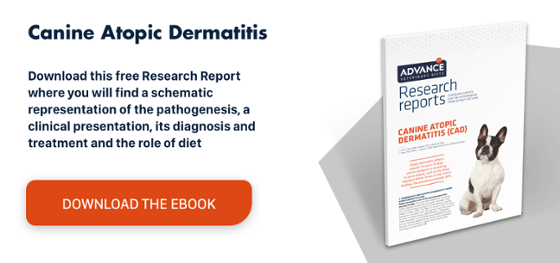Skin disorders in dogs: Malassezia dermatitis
M. pachydermatis is classified as a strictly zoophilic species of commensal yeast whose habitual presence on the skin inhibits the colonisation of other, more pathogenic fungi. The organism is easily isolated from the mouth, ears, genitals and paws of healthy dogs.
Malassezia overgrowth is curbed by normal skin shedding, the fungistatic properties of the skin’s hydrolipidic film and immune mechanisms such as the release of IgA from apocrine gland secretions and cell-mediated immunity. Therefore, any imbalance in these mechanisms results in proliferation and the bacteria becomes pathogenic.
Acquired problems that promote overgrowth include allergies, immunosuppression caused by a hormonal disorder or corticosteroids and the use of antibiotics.
Clinical picture
Malassezia dermatitis mostly affects adult dogs. There is no predisposition for sex or age, but some breeds are prone to overgrowth.
Skin disorders in dogs involving Malassezia are associated with two clinical syndromes:
- Hyperkeratosis–hyperpigmentation syndrome, erythema and crusts. The lesions are pruritic and may smell rancid. Seborrhoea oleosa is usually present, although the lesions may be dry.
- Chronic lesions with alopecia and lichenification.
Malassezia infection is more common in warm months (more skin parasites and pollen allergens and higher ambient humidity). It usually begins in the abdomen, extending to the inguinal and axillary regions or ventral portion of the neck. Infection of the lips and surrounding skin, especially the lower lip, is common. Pododermatitis appears in the form of interdigital erythema and a brown discolouration at the base of the nails when it infects the nail bed. M. pachydermatis is found in the ear canal of healthy dogs but often proliferates alone or with bacteria, causing erythematous and ceruminous otitis externa with pruritus and a reddish-brown ceruminous exudate.
Diagnosis
Cytology is usually carried out to make the diagnosis. Under 400x magnification, the presence of 1–2 Malassezia cells is considered normal in healthy skin, with up to 10 in the ear canal. Histology is not a sensitive test for Malassezia infection as it does not invade the epidermis.
The main differential diagnoses include any condition that causes erythematous pruritic dermatitis with seborrhoea, lichenification and hyperpigmentation. This includes allergies (caused by atopy, food and fleas), superficial pyoderma and keratinisation defects. It is important to remember that almost all of these differential diagnoses may be a trigger for Malassezia infection.
Treatment
The condition is treated with imidazole derivatives; itraconazole at 5 mg/kg daily or ketoconazole at 5–10 mg/kg twice daily for 20 days, together with two weekly therapeutic baths, are recommended for extensive or resistant cases. Topical treatment alone is effective in recent and localised skin infections. Shampoos may include 2–4% chlorhexidine, 2% miconazole, enilconazole, dichlorophen and keratolytic/keratoplastic agents. In resistant or recurrent cases, regular treatment with shampoo may be necessary after systemic treatment has been discontinued.


